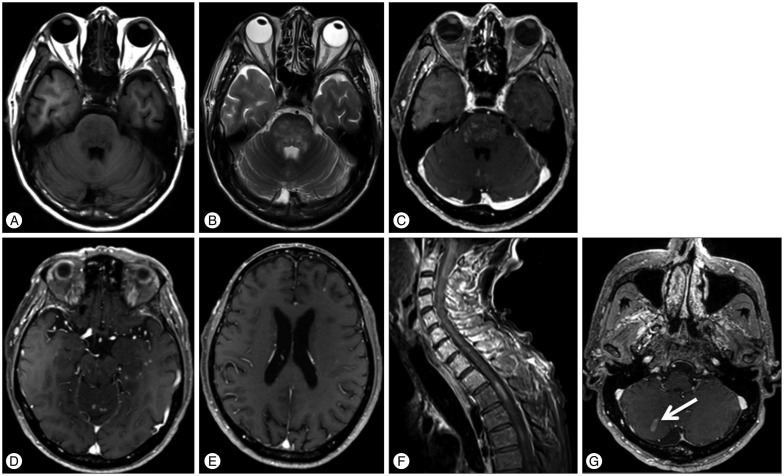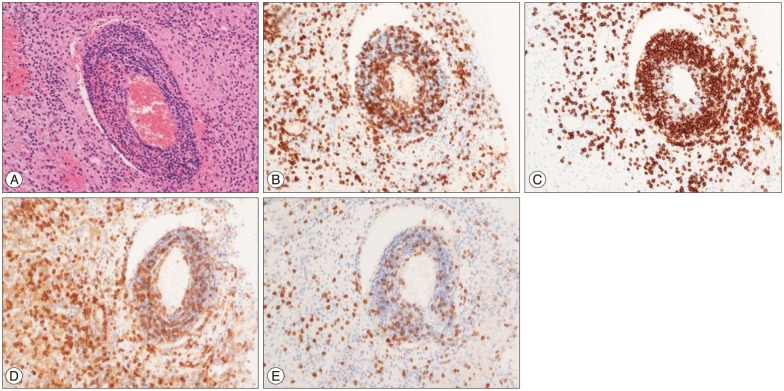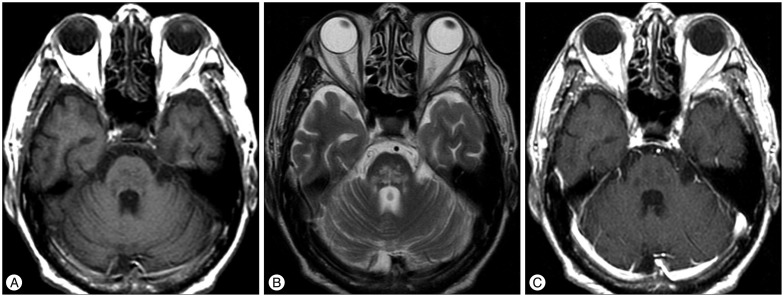J Korean Neurosurg Soc.
2015 Nov;58(5):487-490. 10.3340/jkns.2015.58.5.487.
Chronic Lymphocytic Inflammation with Pontine Perivascular Enhancement Responsive to Steroids with a Significant Elevation of beta-2 Microglobulin Levels
- Affiliations
-
- 1Department of Neurosurgery, Saitama Medical Center, Saitama Medical University, Saitama, Tokyo, Japan. sooya-tky@umin.ac.jp
- 2Department of Radiology, Graduate School of Medicine and Faculty of Medicine, University of Tokyo, Tokyo, Japan.
- KMID: 2191418
- DOI: http://doi.org/10.3340/jkns.2015.58.5.487
Abstract
- Chronic lymphocytic inflammation with pontine perivascular enhancement responsive to steroids (CLIPPERS) is a relapsing-remitting disorder for which steroid administration is a key to control the progression. CLIPPERS can exhibit radiological features similar to malignant lymphoma, whose diagnosis is confounded by prior steroid administration. We report a case of CLIPPERS accompanied by abnormal elevation of beta-2 microglobulin in the cerebrospinal fluid (CSF). A 62-year-old man started to experience numbness in all fingers of his left hand one year ago, which gradually extended to his body trunk and legs on both sides. Magnetic resonance imaging demonstrated numerous small enhancing spots scattered in his brain and spinal cord. CSF levels of beta-2 microglobulin were elevated; although this often indicates central nervous system involvement in leukemia and lymphoma, the lesions were diagnosed as CLIPPERS based on the pathological findings from a biopsy specimen. We emphasize the importance of biopsy to differentiate between CLIPPERS and malignant lymphoma because the temporary radiological response to steroid might be the same in both diseases but the treatment strategies regarding the use of steroid are quite different.
Keyword
MeSH Terms
Figure
Reference
-
1. Bagnato F, Zivadinov R, Cecchinelli D, Tancredi A, Grop A, Pierallini A, et al. beta2-microglobulin serum level is not a marker of disease activity in multiple sclerosis. Eur J Neurol. 2004; 11:455–460. PMID: 15257683.
Article2. Baraniskin A, Kuhnhenn J, Schlegel U, Chan A, Deckert M, Gold R, et al. Identification of microRNAs in the cerebrospinal fluid as marker for primary diffuse large B-cell lymphoma of the central nervous system. Blood. 2011; 117:3140–3146. PMID: 21200023.
Article3. Buttmann M, Metz I, Brecht I, Brück W, Warmuth-Metz M. Atypical chronic lymphocytic inflammation with pontocerebellar perivascular enhancement responsive to steroids (CLIPPERS), primary angiitis of the CNS mimicking CLIPPERS or overlap syndrome? A case report. J Neurol Sci. 2013; 324:183–186. PMID: 23149266.
Article4. Mavlight GM, Stuckey SE, Cabanillas FF, Keating MJ, Tourtellotte WW, Schold SC, et al. Diagnosis of leukemia or lymphoma in the central nervous system by beta 2-microglobulin determination. N Engl J Med. 1980; 303:718–722. PMID: 6157089.
Article5. Oksanen V, Grönhagen-Riska C, Tikanoja S, Somer H, Fyhrquist F. Cerebrospinal fluid lysozyme and beta 2-microglobulin in neurosarcoidosis. J Neurol Sci. 1986; 73:79–87. PMID: 3517236.6. Peterslund NA, Black FT, Geil JP, Mogensen CE. Beta-2-microglobulin in the cerebrospinal fluid of patients with infections of the central nervous system. Acta Neurol Scand. 1989; 80:579–583. PMID: 2694728.
Article7. Pittock SJ, Debruyne J, Krecke KN, Giannini C, van den Ameele J, De Herdt V, et al. Chronic lymphocytic inflammation with pontine perivascular enhancement responsive to steroids (CLIPPERS). Brain. 2010; 133:2626–2634. PMID: 20639547.
Article8. Roy S, Josephson SA, Fridlyand J, Karch J, Kadoch C, Karrim J, et al. Protein biomarker identification in the CSF of patients with CNS lymphoma. J Clin Oncol. 2008; 26:96–105. PMID: 18056677.
Article9. Scott BJ, Douglas VC, Tihan T, Rubenstein JL, Josephson SA. A systematic approach to the diagnosis of suspected central nervous system lymphoma. JAMA Neurol. 2013; 70:311–319. PMID: 23319132.
Article10. Simon NG, Parratt JD, Barnett MH, Buckland ME, Gupta R, Hayes MW, et al. Expanding the clinical, radiological and neuropathological phenotype of chronic lymphocytic inflammation with pontine perivascular enhancement responsive to steroids (CLIPPERS). J Neurol Neurosurg Psychiatry. 2012; 83:15–22. PMID: 22056964.
Article11. Taieb G, Duflos C, Renard D, Audoin B, Kaphan E, Pelletier J, et al. Long-term outcomes of CLIPPERS (chronic lymphocytic inflammation with pontine perivascular enhancement responsive to steroids) in a consecutive series of 12 patients. Arch Neurol. 2012; 69:847–855. PMID: 22777259.
Article12. Taieb G, Wacongne A, Renard D, Figarella-Branger D, Castelnovo G, Labauge P. A new case of chronic lymphocytic inflammation with pontine perivascular enhancement responsive to steroids with initial normal magnetic resonance imaging. Brain. 2011; 134(Pt 8):e182. author reply e183. PMID: 21303857.
Article
- Full Text Links
- Actions
-
Cited
- CITED
-
- Close
- Share
- Similar articles
-
- What is chronic lymphocytic inflammation with pontine perivascular enhancement responsive to steroids?
- The significance of beta 2-microglobulin level in patients with chronic renal failure
- A Case of Cheilitis Granulomatosa
- Primary well differentiated lymphocytic lymphoma of the lung: a clinical and immunohistochemical study of four cases
- Urinary N-Acetyl-beta-D-Glucosaminidase and beta 2-Microglobulin in Children with Various Renal Diseases




